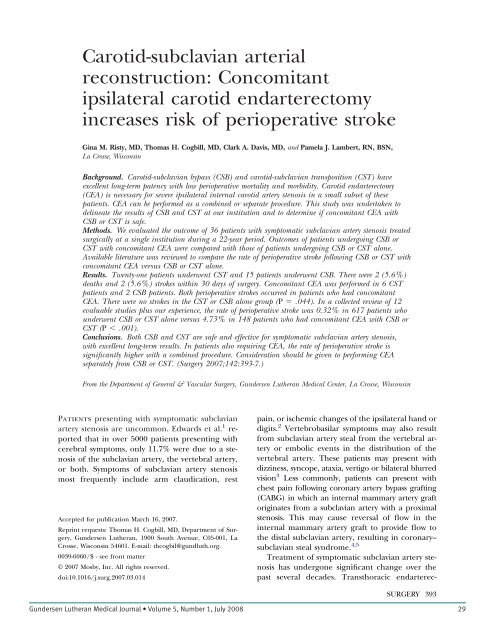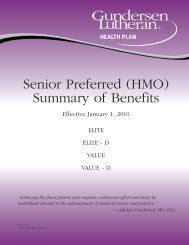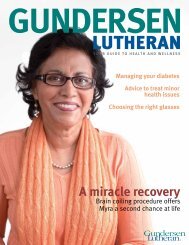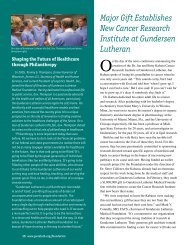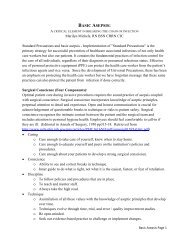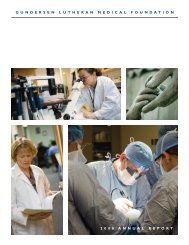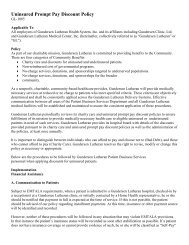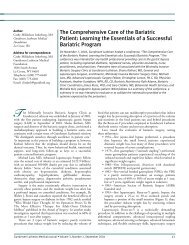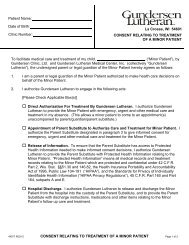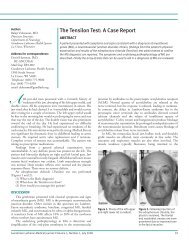ndersen er an - Gundersen Health System
ndersen er an - Gundersen Health System
ndersen er an - Gundersen Health System
Create successful ePaper yourself
Turn your PDF publications into a flip-book with our unique Google optimized e-Paper software.
Carotid-subclavi<strong>an</strong> art<strong>er</strong>ial<br />
reconstruction: Concomit<strong>an</strong>t<br />
ipsilat<strong>er</strong>al carotid endart<strong>er</strong>ectomy<br />
increases risk of p<strong>er</strong>iop<strong>er</strong>ative stroke<br />
Gina M. Risty, MD, Thomas H. Cogbill, MD, Clark A. Davis, MD, <strong>an</strong>d Pamela J. Lamb<strong>er</strong>t, RN, BSN,<br />
La Crosse, Wisconsin<br />
Background. Carotid-subclavi<strong>an</strong> bypass (CSB) <strong>an</strong>d carotid-subclavi<strong>an</strong> tr<strong>an</strong>sposition (CST) have<br />
excellent long-t<strong>er</strong>m patency with low p<strong>er</strong>iop<strong>er</strong>ative mortality <strong>an</strong>d morbidity. Carotid endart<strong>er</strong>ectomy<br />
(CEA) is necessary for sev<strong>er</strong>e ipsilat<strong>er</strong>al int<strong>er</strong>nal carotid art<strong>er</strong>y stenosis in asmall subset of these<br />
patients. CEA c<strong>an</strong> be p<strong>er</strong>formed as acombined or separate procedure. This study was und<strong>er</strong>taken to<br />
delineate the results of CSB <strong>an</strong>d CST at our institution <strong>an</strong>d to det<strong>er</strong>mine if concomit<strong>an</strong>t CEA with<br />
CSB or CST is safe.<br />
Methods. We evaluated the outcome of 36 patients with symptomatic subclavi<strong>an</strong> art<strong>er</strong>y stenosis treated<br />
surgically at asingle institution during a22-year p<strong>er</strong>iod. Outcomes of patients und<strong>er</strong>going CSB or<br />
CST with concomit<strong>an</strong>t CEA w<strong>er</strong>e compared with those of patients und<strong>er</strong>going CSB or CST alone.<br />
Available lit<strong>er</strong>ature was reviewed to compare the rate of p<strong>er</strong>iop<strong>er</strong>ative stroke following CSB or CST with<br />
concomit<strong>an</strong>t CEA v<strong>er</strong>sus CSB or CST alone.<br />
Results. Twenty-one patients und<strong>er</strong>went CST <strong>an</strong>d 15 patients und<strong>er</strong>went CSB. Th<strong>er</strong>e w<strong>er</strong>e 2(5.6%)<br />
deaths <strong>an</strong>d 2(5.6%) strokes within 30 days of surg<strong>er</strong>y. Concomit<strong>an</strong>t CEA was p<strong>er</strong>formed in 6CST<br />
patients <strong>an</strong>d 2CSB patients. Both p<strong>er</strong>iop<strong>er</strong>ative strokes occurred in patients who had concomit<strong>an</strong>t<br />
CEA. Th<strong>er</strong>e w<strong>er</strong>e no strokes in the CST or CSB alone group (P .044). In acollected review of 12<br />
evaluable studies plus our exp<strong>er</strong>ience, the rate of p<strong>er</strong>iop<strong>er</strong>ative stroke was 0.32% in 617 patients who<br />
und<strong>er</strong>went CSB or CST alone v<strong>er</strong>sus 4.73% in 148 patients who had concomit<strong>an</strong>t CEA with CSB or<br />
CST (P .001).<br />
Conclusions. Both CSB <strong>an</strong>d CST are safe <strong>an</strong>d effective for symptomatic subclavi<strong>an</strong> art<strong>er</strong>y stenosis,<br />
with excellent long-t<strong>er</strong>m results. In patients also requiring CEA, the rate of p<strong>er</strong>iop<strong>er</strong>ative stroke is<br />
signific<strong>an</strong>tly high<strong>er</strong> with acombined procedure. Consid<strong>er</strong>ation should be given to p<strong>er</strong>forming CEA<br />
separately from CSB or CST. (Surg<strong>er</strong>y 2007;142:393-7.)<br />
From the Department of Gen<strong>er</strong>al &Vascular Surg<strong>er</strong>y, Gu<strong>nd<strong>er</strong>sen</strong> Luth<strong>er</strong><strong>an</strong> Medical Cent<strong>er</strong>, La Crosse, Wisconsin<br />
Patients presenting with symptomatic subclavi<strong>an</strong><br />
art<strong>er</strong>y stenosis are uncommon. Edwards et al. 1 reported<br />
that in ov<strong>er</strong> 5000 patients presenting with<br />
c<strong>er</strong>ebral symptoms, only 11.7% w<strong>er</strong>e due to astenosis<br />
of the subclavi<strong>an</strong> art<strong>er</strong>y, the v<strong>er</strong>tebral art<strong>er</strong>y,<br />
or both. Symptoms of subclavi<strong>an</strong> art<strong>er</strong>y stenosis<br />
most frequently include arm claudication, rest<br />
Accepted for publication March 16, 2007.<br />
Reprint requests: Thomas H. Cogbill, MD, Department of Surg<strong>er</strong>y,<br />
Gu<strong>nd<strong>er</strong>sen</strong> Luth<strong>er</strong><strong>an</strong>, 1900 South Avenue, C05-001, La<br />
Crosse, Wisconsin 54601. E-mail: thcogbil@gundluth.org.<br />
0039-6060/$ -see front matt<strong>er</strong><br />
© 2007 Mosby, Inc. All rights res<strong>er</strong>ved.<br />
doi:10.1016/j.surg.2007.03.014<br />
pain, or ischemic ch<strong>an</strong>ges of the ipsilat<strong>er</strong>al h<strong>an</strong>d or<br />
digits. 2 V<strong>er</strong>tebrobasilar symptoms may also result<br />
from subclavi<strong>an</strong> art<strong>er</strong>y steal from the v<strong>er</strong>tebral art<strong>er</strong>y<br />
or embolic events in the distribution of the<br />
v<strong>er</strong>tebral art<strong>er</strong>y. These patients may present with<br />
dizziness, syncope, ataxia, v<strong>er</strong>tigo or bilat<strong>er</strong>al blurred<br />
vision 3 Less commonly, patients c<strong>an</strong> present with<br />
chest pain following coronary art<strong>er</strong>y bypass grafting<br />
(CABG) in which <strong>an</strong> int<strong>er</strong>nal mammary art<strong>er</strong>y graft<br />
originates from asubclavi<strong>an</strong> art<strong>er</strong>y with aproximal<br />
stenosis. This may cause rev<strong>er</strong>sal of flow in the<br />
int<strong>er</strong>nal mammary art<strong>er</strong>y graft to provide flow to<br />
the distal subclavi<strong>an</strong> art<strong>er</strong>y, resulting in coronary–<br />
subclavi<strong>an</strong> steal syndrome. 4,5<br />
Treatment of symptomatic subclavi<strong>an</strong> art<strong>er</strong>y stenosis<br />
has und<strong>er</strong>gone signific<strong>an</strong>t ch<strong>an</strong>ge ov<strong>er</strong> the<br />
past sev<strong>er</strong>al decades. Tr<strong>an</strong>sthoracic endart<strong>er</strong>ec-<br />
SURGERY 393<br />
Gu<strong>nd<strong>er</strong>sen</strong> Luth<strong>er</strong><strong>an</strong> Medical Journal • Volume 5, Numb<strong>er</strong> 1, July 2008 29


